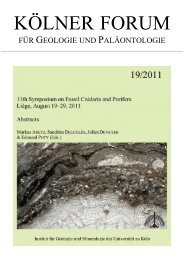Download (6Mb) - USP Electronic Research Repository - The ...
Download (6Mb) - USP Electronic Research Repository - The ...
Download (6Mb) - USP Electronic Research Repository - The ...
Create successful ePaper yourself
Turn your PDF publications into a flip-book with our unique Google optimized e-Paper software.
Benthic Marine Algae of Rotuma Island 3 89<br />
Halimeda triloba Decaisne 1842: 102.<br />
Halimeda opuntia (Linnaeus) Lamouroux f. triloba (Decaisne) J. Agardh 1887: 84;<br />
Taylor 1960: 176; Verheij and Prud'homme van Reine 1993: 138, pl. 6, fig. 6.<br />
?Halimeda opuntia (Linnaeus) Lamouroux var. macrocarpa Askenasy.<br />
(Fig. 70a-c)<br />
Fijian Records<br />
Askenasy 1888; Chapman 1971: 166; Kasahara 1985: 22, pl. 2, fig. 3; Kasahara 1988;<br />
South 1991: 5; South 1992: 9, figs 26-28; South and Kasahara 1992: 51.<br />
Halimeda opuntia (Linnaeus) Lamouroux var. opuntia Hillis 1959: 360, pl. 2, fig. 8; pl.<br />
5, fig. 3; Chapman 1977: 162; Wynne 1993: 23, fig. 11.<br />
(Figs 70b, 83)<br />
Plants bushy and possessing multiple attachment points; branching dense and irregular to<br />
opposite, in many planes. Clumps to 10 cm in diameter, 6 cm high. Segments 10 mm broad<br />
to 5 mm high, reniform, ribbed and trilobed at base of plant. Colour light to dark green, basal<br />
segments often white. Cortical utricles small, rounded and slightly adhering in surface view<br />
10-12 p,m in diameter. Secondary utricles slender and fork-shaped, arising as dichotomies of<br />
the medullary filaments.<br />
Distribution<br />
Tropical Pacific and Indian Oceans.<br />
Rotuman Distribution<br />
Fapufa (Fl); Hofe'a (H46, H82, H105, H110, 11 1, H200, H202, H206, H219, 220);<br />
Oinafa (015, 023, 036, 37, 040,41, 043, 045, 047, 049, 0531 <strong>USP</strong> 397, 056, 059, 071,<br />
72,075); Tua'koi (Tll <strong>USP</strong> 399, T2).<br />
Habitat and Remarks<br />
Most common Halimeda sp. on Rotuman reefs, found at all sites and often in exposed<br />
places (e.g. edge of reef) where its low-profile habit and strong attachment mode offer a<br />
distinct advantage over other species. In sheltered, sandy sites (e.g. Isilepi at Hapmafau) this<br />
species forms large clumps up to 1 m in diameter in shallow water, often in association with<br />
epiphytic Caulerpa racemosa and C, serrulata.<br />
Halimeda opuntzh (Linnaeus) Lamouroux var. hederacea (Barton) Hillis 1959: 360, pl. 2,<br />
fig. 7; pl. 5, fig. 4; Taylor 1950: 81, pl. 40, fig. 1; Dawson 1956: 42; 1957: 109; Payri and<br />
Meinesz 1985a: 509; Lewis 1987: 3 1.<br />
Halimeda opuntia f. hederacea Barton 1901: 21, pl. 2, fig. 23 (type locality: Indonesia).<br />
Halimeda opuntia forma Taylor 1950: 83.<br />
?Halimeda incrassataJ: distorta Yamada 1941: 119, fig. p. 120; Yamada 1944: 28, pl. 4.<br />
(Figs 70c, 84)<br />
Plants bushy and loose in habit, with multiple holdfasts, forming distinctive net-like<br />
complexes. Heavily calcified, light green to white in colour. Does not form clumps, but<br />
rather assumes a creeping or hanging habit. Segments up to 6 mm broad and 5 mm high,<br />
trilobed at base of plant, becoming reniform to oval at outer portions, very slightly ribbed.<br />
Peripheral utricles hexagonal in surface view, 24-27 p.m in diameter.

















